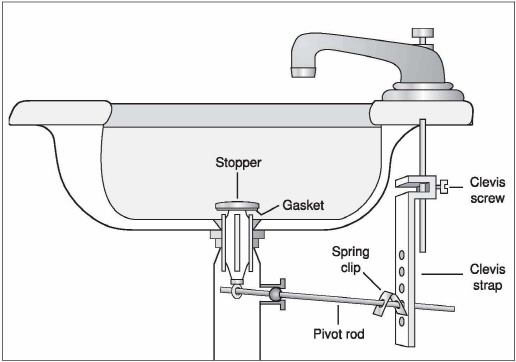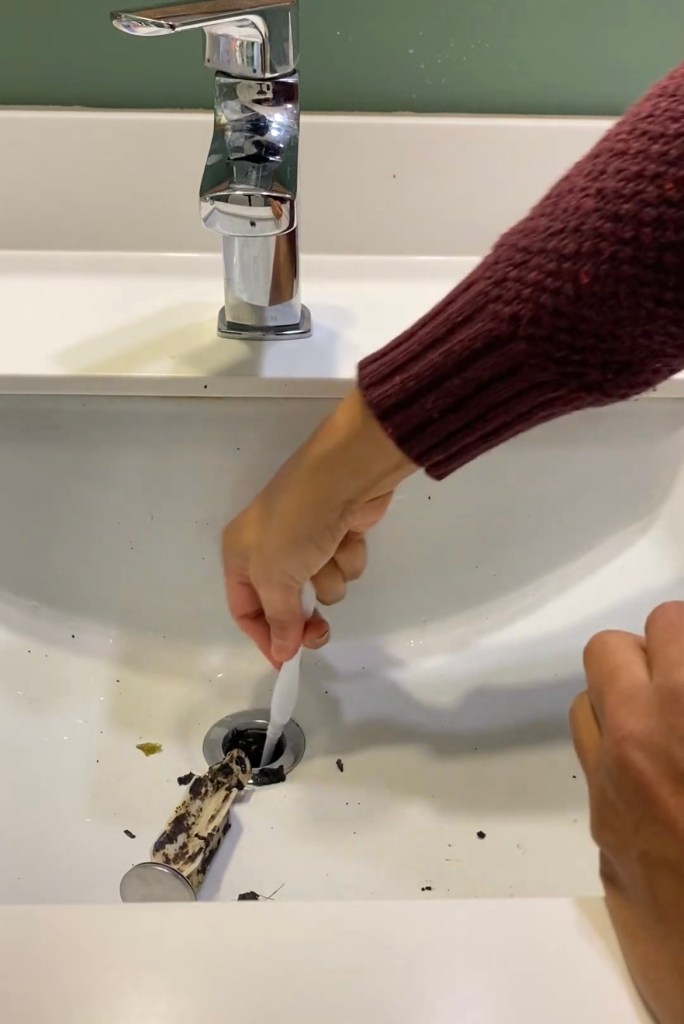To unclog a bathroom sink filled with hair, start by using a plunger or a drain snake. For a natural solution, pour baking soda followed by vinegar down the drain, wait, then flush with hot water.
Dealing with a clogged bathroom sink can be a nuisance, particularly when hair is the culprit. This common household problem not only disrupts daily routines but also poses hygiene issues if left untreated. Homeowners and renters alike seek quick and effective methods to restore their sink’s functionality without always resorting to professional help.
The key is to tackle the blockage promptly using tools like plungers or more natural approaches involving household items like baking soda and vinegar. This method avoids harsh chemicals and can often save the day, ensuring your bathroom sink is back in working order in no time. With the right technique and a bit of patience, the inconvenience of a hair-clogged sink can be a problem of the past.
Introduction To Clogged Bathroom Sinks
Dealing with a clogged bathroom sink can be a nuisance. Often, a clog forms without warning, leading to water backing up and draining slowly. Understanding the common culprits behind these blockages is essential for quick and effective solutions.
Common Causes Of Clogs
Bathroom sinks endure daily use, leading to inevitable clogs. Soap residue, toothpaste, and small objects often contribute to blockages. Hair, however, is a leading cause of sink clogs, entangling other debris and creating stubborn blockages.
Impact Of Hair Build-up
Hair build-up in drains is a significant issue. Over time, strands of hair collect and intertwine, forming a net that traps other particles. This can lead to slow draining and eventually complete blockage, requiring immediate attention.

Credit: www.youtube.com
Initial Assessment Of The Blockage
Before you tackle a clogged bathroom sink, an initial assessment is key. This step helps you understand what you’re dealing with. Let’s dive in and figure out how to approach this hairy situation.
Identifying The Severity
First, check how bad the clog is. You can do this easily.
- Run water to see how fast it drains.
- Look for visible hair and debris near the drain.
- Use a flashlight for a better view.
If water drains slowly or not at all, you have a severe blockage.
Safety Considerations
Next, think about safety. Working with drains involves care.
- Wear gloves to protect your hands.
- Keep your face away from the drain to avoid splashes.
- Use tools carefully to prevent damage to the sink.
Remember, safety first always keeps you protected.
Diy Quick Fixes For Hair Clogs
A clogged bathroom sink is a nuisance that disrupts daily routines. Hair clogs are often the culprit. Before calling a plumber, try these quick, easy DIY solutions. They can clear hair-clogged pipes using common household items. These methods are effective and eco-friendly.
Boiling Water Technique
Boiling water can dissolve some types of blockages. It is a simple first step.
- Boil a kettle of water.
- Carefully pour it directly down the drain.
- Wait a few minutes.
- Test the sink. Repeat if necessary.
Remember, boiling water is not suitable for PVC pipes. It can damage them.
Natural Vinegar And Baking Soda Solution
This natural combo creates a fizzy reaction that can break down hair clogs. Follow these steps:
- Pour 1 cup of baking soda into the drain.
- Follow with 1 cup of vinegar.
- Cover the drain to contain the reaction.
- Wait for 15 minutes.
- Rinse with hot water.
This method is safe for all pipes and eco-friendly.
Manual Removal Methods
Manual removal methods provide a quick fix for a hair-clogged bathroom sink. These methods require common household items. They are effective and easy to execute. Let’s explore two hands-on techniques to tackle this hairy issue.
Using A Wire Hanger
A simple wire hanger can transform into a clog-removing tool. First, straighten the hanger, but keep the hook. Carefully insert the hook into the drain. Twist and pull gently to remove hair clumps. Follow these steps:
- Unwind the wire hanger to create a long piece.
- Maintain the hook on one end for gripping hair.
- Insert the hook into the drain slowly.
- Rotate it to latch onto the hair.
- Pull up the hair and dispose of it properly.
Employing A Drain Claw
A drain claw is a specialized tool designed for clog removal. It has tiny interlocking hooks to grab hair. To use a drain claw, insert it into the drain until it reaches the clog. Pull it out to remove the hair. Here’s how to do it:
- Insert the drain claw into the sink drain.
- Push until you feel resistance from the clog.
- Twist the handle to catch hair.
- Extract the claw and clean off the hair.
- Repeat if necessary to clear all hair.
Plunger Power
Let’s talk about a hero in our bathroom: the plunger. Plunger Power can save the day when you face a sink clogged with hair. It’s simple yet effective. Here’s how to use it right.
Proper Plunging Technique
To start, you’ll need a clean plunger. Make sure it’s a cup plunger, not a flange one. The flange plunger is for toilets. Here’s the right way to plunge a sink:
- Fill the sink with enough water to cover the plunger’s cup.
- Place the plunger over the drain, making a tight seal.
- Pump the plunger up and down without lifting it off the drain. Do this for 20 seconds.
- Quickly pull the plunger off. This creates a pressure change that can dislodge clogs.
- Repeat if needed. Often, two or three attempts are necessary.
When To Use A Plunger
A plunger works best for small to moderate clogs. Especially those close to the drain’s surface. Use it:
- After you notice the water draining slowly.
- If there’s visible hair near the drain opening.
- Before trying chemical cleaners. Chemicals can be harsh on pipes.
Remember, persistence and patience are key with a plunger. Give it a few tries before moving on to other methods. This simple tool might just clear that annoying clog, keeping your bathroom sink flowing smoothly.
Chemical Drain Cleaners: A Cautionary Tale
Bathroom sinks clogged with hair challenge many households. Quick fixes may tempt you. Chemical drain cleaners promise fast results. Yet, they hold secrets. This tale unfolds the good, the bad, and the ugly about these powerful potions.
Selecting The Right Cleaner
Not all cleaners are equal. Choose wisely. Consider your pipes and the clog type. Some cleaners suit metal pipes; others are for PVC. Read labels. Seek a hair-specific formula. It should target hair clogs without harming pipes.
Potential Risks And Precautions
Chemical drain cleaners pack a punch. With great power comes great responsibility. Understand the risks:
- Toxic fumes may harm your health.
- Pipe damage could follow improper use.
- Skin burns are possible with direct contact.
Take precautions:
- Wear gloves and eye protection.
- Ensure good ventilation in your bathroom.
- Follow instructions to the letter.
Consider non-chemical alternatives first. Plungers and drain snakes offer safer solutions. If chemicals are your last resort, use them with care.
Plumbing Tools To The Rescue
Bathroom sink clogs can disrupt your daily routine.
But with the right plumbing tools, you can get back on track quickly.
Hair is often the culprit in these clogs, creating a tangled mess in your pipes.
Two essential tools can make all the difference: drain snakes and sink plungers.
Let’s explore how these tools can help clear that stubborn blockage.
Utilizing a Drain Snake
Utilizing A Drain Snake
A drain snake, also known as a plumbing auger, is perfect for hair clogs.
- Insert the snake into the drain.
- Twist to catch hair.
- Pull out the clog.
This tool reaches deep, grabbing hair others miss.
The Benefits of a Sink Plunger
The Benefits Of A Sink Plunger
A sink plunger can create powerful suction.
- Fill the sink with water.
- Place the plunger over the drain.
- Pump the plunger to clear the clog.
It’s a quick solution for minor clogs.
Preventive Measures And Maintenance
Keeping your bathroom sink clear of hair clogs starts with daily habits. Proper maintenance can save you time and money. Let’s explore the best practices to prevent hair from clogging your sink.
Regular Cleaning Routines
Regular sink cleaning stops clogs before they start. A weekly routine works best. Use these steps:
- Run hot water through the sink to loosen buildup.
- Apply a natural cleaner, like baking soda and vinegar.
- Finish with more hot water to rinse away any remaining debris.
Consistent cleaning keeps sinks clear and functional.
Hair Catcher Installations
A hair catcher is a sink’s best friend. It traps hair before it enters the drain. Here’s how to use one:
- Choose a hair catcher that fits your sink.
- Place it over the drain before each use.
- Clean it out after use to ensure it works properly.
This simple tool can prevent most hair clogs.
When To Call A Professional
At times, a clogged bathroom sink requires professional attention.
Do-it-yourself methods don’t always work. Knowing when to call a plumber is key.
Signs Of Persistent Clogging
- Water drains slowly even after multiple attempts to clear it.
- There’s water backing up frequently.
- Foul odors come from the drain, suggesting buildup.
- Strange gurgling sounds occur during water flow.
- DIY efforts, like plungers or drain snakes, fail to resolve the issue.
Benefits Of Professional Help
| Benefit | Description |
|---|---|
| Expertise | Plumbers have the right skills to clear tough clogs. |
| Efficiency | They use tools that quickly and effectively remove hair and debris. |
| Prevention | Professionals can suggest ways to prevent future clogs. |
| Safety | They avoid damage to pipes that DIY methods might cause. |

Credit: happyhiller.com
Conclusion: Maintaining A Hair-free Sink
A clean sink makes a happy bathroom. Let’s keep hair away!
Summary Of Best Practices
- Use a drain cover to catch hair before it enters.
- Brush hair before showering to reduce shed in the sink.
- Clean the drain with baking soda and vinegar monthly.
- Install a hair catcher for extra protection.
Final Thoughts On Clog Prevention
Stopping hair clogs is easy with the right steps. A hair-free sink saves time and stress. Use these tips and say goodbye to clogs!

Credit: hanashappyhome.com
Frequently Asked Questions
What Causes Sink Clogs By Hair?
Hair binds with soap scum and other substances, creating blockages in the pipes that prevent water from draining properly.
How Can You Remove Hair From A Sink Drain?
Gently pull out clumps of hair using needle-nose pliers or a wire hanger. For stubborn clogs, consider a drain snake or a chemical hair dissolver.
Are Chemical Drain Cleaners Safe For Bathroom Sinks?
While effective, chemical drain cleaners can be harsh on pipes. Use them sparingly and follow the manufacturer’s instructions to avoid damage.
Can Baking Soda And Vinegar Clear A Hair Clog?
Yes, baking soda and vinegar can help dissolve hair clogs. Pour a mixture down the drain, let it sit, and flush with hot water.
What Preventative Measures Avoid Sink Clogs?
Regularly clean the stopper, avoid letting hair down the drain, and use a drain guard to catch hair before it causes clogs.
Conclusion
Clearing a bathroom sink clogged with hair doesn’t have to be daunting. With the right tools and techniques, you can easily tackle this common issue. Remember, prevention is key. Regularly cleaning your sink will save you time and hassle in the future.
Say goodbye to clogs and hello to a smoothly running bathroom sink.

